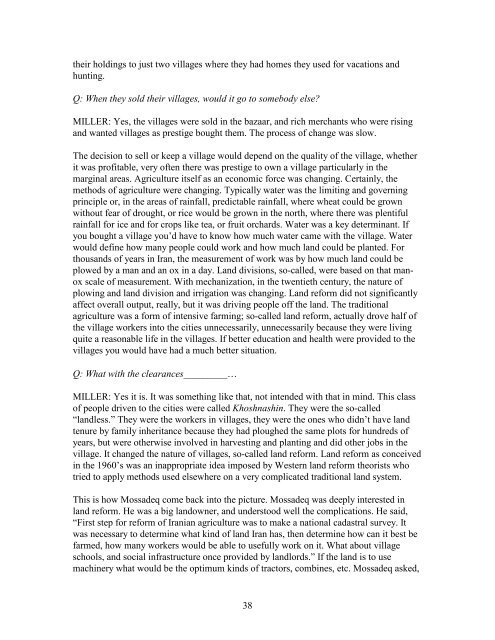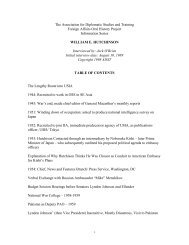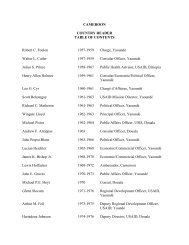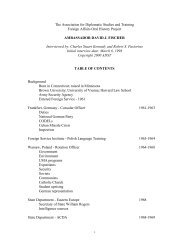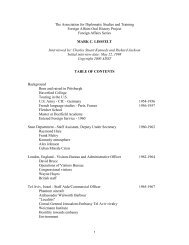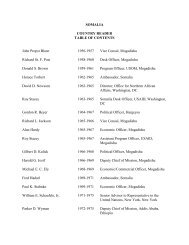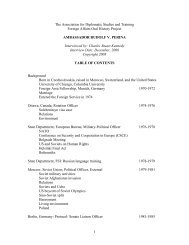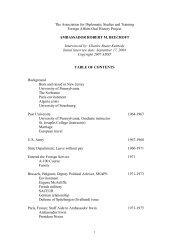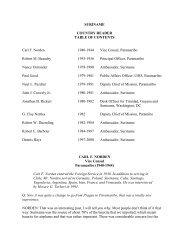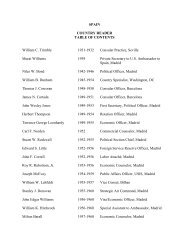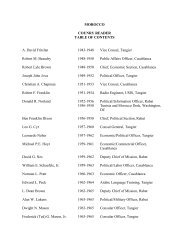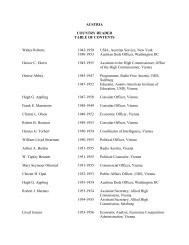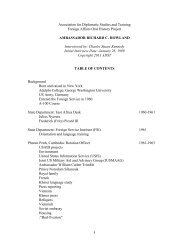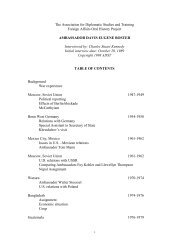1 The Association for Diplomatic Studies and Training Foreign ...
1 The Association for Diplomatic Studies and Training Foreign ...
1 The Association for Diplomatic Studies and Training Foreign ...
You also want an ePaper? Increase the reach of your titles
YUMPU automatically turns print PDFs into web optimized ePapers that Google loves.
their holdings to just two villages where they had homes they used <strong>for</strong> vacations <strong>and</strong><br />
hunting.<br />
Q: When they sold their villages, would it go to somebody else?<br />
MILLER: Yes, the villages were sold in the bazaar, <strong>and</strong> rich merchants who were rising<br />
<strong>and</strong> wanted villages as prestige bought them. <strong>The</strong> process of change was slow.<br />
<strong>The</strong> decision to sell or keep a village would depend on the quality of the village, whether<br />
it was profitable, very often there was prestige to own a village particularly in the<br />
marginal areas. Agriculture itself as an economic <strong>for</strong>ce was changing. Certainly, the<br />
methods of agriculture were changing. Typically water was the limiting <strong>and</strong> governing<br />
principle or, in the areas of rainfall, predictable rainfall, where wheat could be grown<br />
without fear of drought, or rice would be grown in the north, where there was plentiful<br />
rainfall <strong>for</strong> ice <strong>and</strong> <strong>for</strong> crops like tea, or fruit orchards. Water was a key determinant. If<br />
you bought a village you’d have to know how much water came with the village. Water<br />
would define how many people could work <strong>and</strong> how much l<strong>and</strong> could be planted. For<br />
thous<strong>and</strong>s of years in Iran, the measurement of work was by how much l<strong>and</strong> could be<br />
plowed by a man <strong>and</strong> an ox in a day. L<strong>and</strong> divisions, so-called, were based on that manox<br />
scale of measurement. With mechanization, in the twentieth century, the nature of<br />
plowing <strong>and</strong> l<strong>and</strong> division <strong>and</strong> irrigation was changing. L<strong>and</strong> re<strong>for</strong>m did not significantly<br />
affect overall output, really, but it was driving people off the l<strong>and</strong>. <strong>The</strong> traditional<br />
agriculture was a <strong>for</strong>m of intensive farming; so-called l<strong>and</strong> re<strong>for</strong>m, actually drove half of<br />
the village workers into the cities unnecessarily, unnecessarily because they were living<br />
quite a reasonable life in the villages. If better education <strong>and</strong> health were provided to the<br />
villages you would have had a much better situation.<br />
Q: What with the clearances_________…<br />
MILLER: Yes it is. It was something like that, not intended with that in mind. This class<br />
of people driven to the cities were called Khoshnashin. <strong>The</strong>y were the so-called<br />
“l<strong>and</strong>less.” <strong>The</strong>y were the workers in villages, they were the ones who didn’t have l<strong>and</strong><br />
tenure by family inheritance because they had ploughed the same plots <strong>for</strong> hundreds of<br />
years, but were otherwise involved in harvesting <strong>and</strong> planting <strong>and</strong> did other jobs in the<br />
village. It changed the nature of villages, so-called l<strong>and</strong> re<strong>for</strong>m. L<strong>and</strong> re<strong>for</strong>m as conceived<br />
in the 1960’s was an inappropriate idea imposed by Western l<strong>and</strong> re<strong>for</strong>m theorists who<br />
tried to apply methods used elsewhere on a very complicated traditional l<strong>and</strong> system.<br />
This is how Mossadeq come back into the picture. Mossadeq was deeply interested in<br />
l<strong>and</strong> re<strong>for</strong>m. He was a big l<strong>and</strong>owner, <strong>and</strong> understood well the complications. He said,<br />
“First step <strong>for</strong> re<strong>for</strong>m of Iranian agriculture was to make a national cadastral survey. It<br />
was necessary to determine what kind of l<strong>and</strong> Iran has, then determine how can it best be<br />
farmed, how many workers would be able to usefully work on it. What about village<br />
schools, <strong>and</strong> social infrastructure once provided by l<strong>and</strong>lords.” If the l<strong>and</strong> is to use<br />
machinery what would be the optimum kinds of tractors, combines, etc. Mossadeq asked,<br />
38


